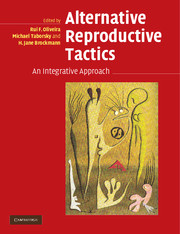Book contents
- Frontmatter
- Contents
- List of contributors
- Preface
- 1 The evolution of alternative reproductive tactics: concepts and questions
- PART I ULTIMATE CAUSES AND ORIGINS OF ALTERNATIVE REPRODUCTIVE TACTICS
- PART II PROXIMATE MECHANISMS OF ALTERNATIVE REPRODUCTIVE TACTICS
- PART III TAXONOMIC REVIEWS OF ALTERNATIVE REPRODUCTIVE TACTICS
- PART IV EMERGING PERSPECTIVES ON ALTERNATIVE REPRODUCTIVE TACTICS
- 16 Communication and the evolution of alternative reproductive tactics
- 17 Alternative mating tactics and mate choice for good genes or good care
- 18 Conflict between the sexes and alternative reproductive tactics within a sex
- 19 Cooperative breeding as an alternative reproductive tactic
- 20 Integrating mechanisms and function: prospects for future research
- Index of species
- Subject index
- References
17 - Alternative mating tactics and mate choice for good genes or good care
Published online by Cambridge University Press: 10 August 2009
- Frontmatter
- Contents
- List of contributors
- Preface
- 1 The evolution of alternative reproductive tactics: concepts and questions
- PART I ULTIMATE CAUSES AND ORIGINS OF ALTERNATIVE REPRODUCTIVE TACTICS
- PART II PROXIMATE MECHANISMS OF ALTERNATIVE REPRODUCTIVE TACTICS
- PART III TAXONOMIC REVIEWS OF ALTERNATIVE REPRODUCTIVE TACTICS
- PART IV EMERGING PERSPECTIVES ON ALTERNATIVE REPRODUCTIVE TACTICS
- 16 Communication and the evolution of alternative reproductive tactics
- 17 Alternative mating tactics and mate choice for good genes or good care
- 18 Conflict between the sexes and alternative reproductive tactics within a sex
- 19 Cooperative breeding as an alternative reproductive tactic
- 20 Integrating mechanisms and function: prospects for future research
- Index of species
- Subject index
- References
Summary
CHAPTER SUMMARY
Many mating systems are characterized by male alternative life histories that utilize different mating tactics to reproduce. Bourgeois males attempt to monopolize mating access to females, and in fish, many of these males provide sole parental care to the developing young. Parasitic males use behavior patterns such as sneaking to steal fertilizations from bourgeois males. Modeling has shown that when bourgeois males provide higher genetic benefits – i.e., alleles leading to increased condition and higher fitness of their offspring – than parasitic males, females maximize both indirect and direct (parental care) benefits by mating exclusively with bourgeois males. However, when parasitic males have higher genetic benefits than bourgeois males, females must trade off genetic quality of their offspring with reduced parental care. Here I develop a model to examine such trade-offs and show that as the relative genetic benefits of parasitic versus bourgeois males increase or as the fitness benefit of parental care decreases, females maximize their fitness by having a greater proportion of their offspring sired by parasitic males. The optimal breeding situation, which maximizes individual fitness, differs for females, parasitic males, and bourgeois males and this should lead to sexual conflict. I test the model with data from bluegill sunfish (Lepomis macrochirus), where parasitic males may provide greater genetic benefits to females than bourgeois males. I show that high-quality females, as measured by three phenotypic measures, spawn in nests that have higher bourgeois male paternity and their offspring subsequently receive greater parental care.
- Type
- Chapter
- Information
- Alternative Reproductive TacticsAn Integrative Approach, pp. 421 - 434Publisher: Cambridge University PressPrint publication year: 2008
References
- 5
- Cited by



